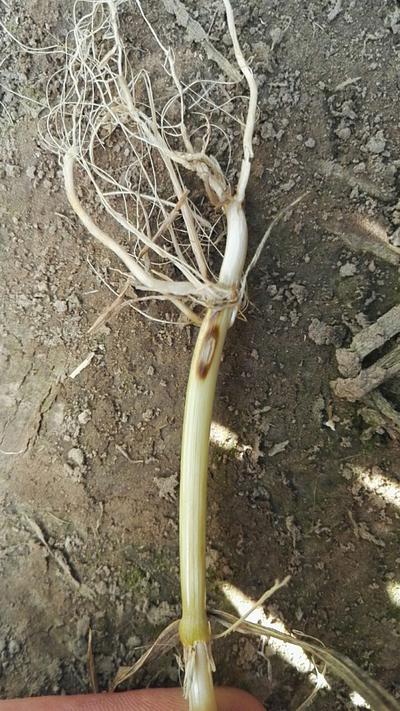Eyespot of Cereals
Oculimacula yallundae
Fungus
In a Nutshell
- Spores develop after infected stubble becomes wet at the start of the season.
- Dark brown to greenish brown smudge on the leaf sheath and elliptical lesions on base of stem. Lesions develop very slowly and are usually not visible until mid to late grain fill.
Can also be found in
Symptoms
Infections during the seedling stage can lead to dieback of the plants. Round, eye-shaped lesions appear at the base of the stem. They have straw-colored centers and are bordered by greenish to dark brown rings. In many cases, eyespots emerge at the leaf sheath near the soil. These lesions might grow together and girdle the stem, losing their typical round shape. This reduces water and nutrient uptake and can cause white, wilting inflorescences and loss of yield. As the disease progresses, it weakens the stem and makes it prone to lodging. The roots are not affected by “eyespot” and show none of the symptoms described above.
Recommendations

Organic Control
Sorry, we don't know of any alternative treatment against Oculimacula yallundae. Please get in touch with us in case you know of something that might help to fight this disease. Looking forward to hearing from you.

Chemical Control
Always consider an integrated approach with preventive measures and biological treatments if available. Most fungicides are hazardous to health or environment and therefore not recommended for use. The most effective fungicides are based on boscalid and the triazole prothioconazole. Cyprodinil is also effective, but has a limited control range of other cereal diseases.
What caused it?
The disease is caused by the fungus Oculimacula yallundae. It that can survive in crop debris in soils for long periods (2 years or more). The primary infection occurs at favorable conditions during the spring, when the spores are carried by rain or winds from plant residues onto the crop. Only basal areas of the plant are infected by the fungus. Mild and moist weather conditions (dew, fogs), and frequent rains in autumn and spring support the life cycle of the fungus and the infection process. Once the lesions penetrate the stem, higher temperatures favor the development of the disease. Crop rotation with other cereals like rye and oats promotes its distribution and leads to an increased chance of infection.
Preventive Measures
- Grow stable and resistant varieties.
- Ensure shallow seed placements at planting.
- Avoid sowing too early.
- Make well defined furrows to avoid primary infection.
- Plan and implement a crop rotation with non-host species.
- Remove and destroy stubbles after harvest.
- Try to improve your canopy by keeping a wider distance at planting.



